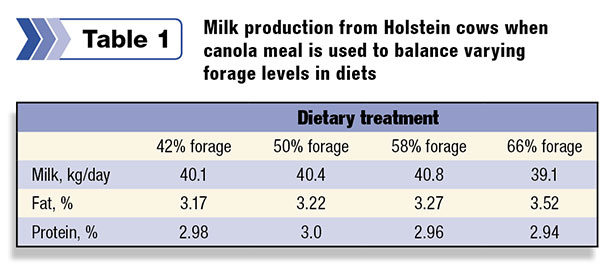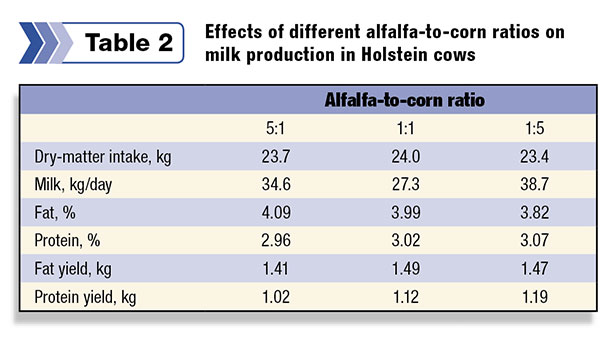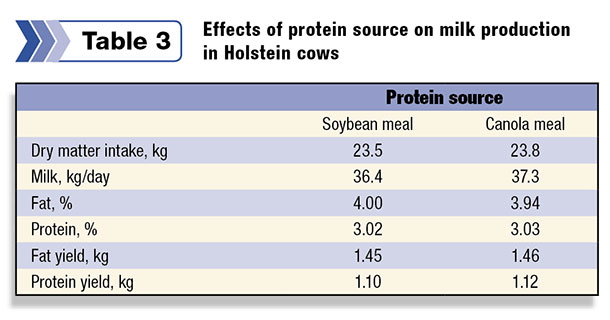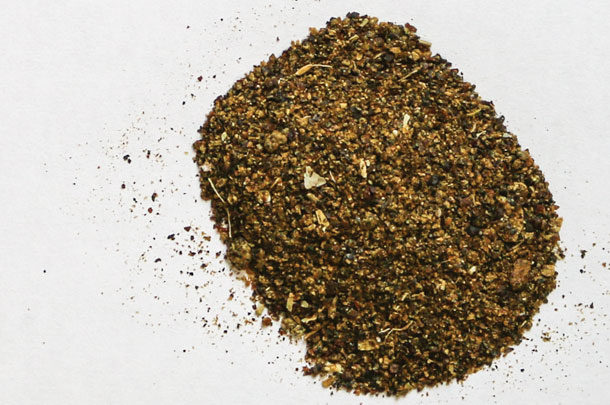In addition to reducing costs, these high-forage diets can support higher milkfat and protein components and better health.
Just like high-concentrate diets, high-forage diets need to be well balanced in order to achieve production goals and to maintain body condition scores for the herd. Surprisingly, it can actually be more difficult to balance for protein with high-forage diets.
Protein produced by rumen microbes is an exceptionally good source of amino acids for milk production. Rumen microbial protein production is related to the amount of energy available in the rumen.
With less energy from concentrate ingredients, more escape – or bypass – protein needs to be provided, and the amino acid composition of the escape protein is crucial to the production outcomes of feeding.
Formulators often look for high-energy concentrate ingredients when balancing diets high in forage content. Book values for canola meal show the energy value is lower than soybean meal. This is in fact the case, as canola meal contains more fibre than soybean meal.
However, there is research to show that canola meal can actually help to ensure rations are well balanced when forage levels are increased.
First, the amino acids in canola meal are very similar to the amino acids in microbial protein. Second, canola meal is a good source of escape protein and can, in essence, replace microbial protein.
One recent study conducted at South Dakota State University showed that milk production was maintained as forage in the diet was elevated.
The diets tested ranged from 42 percent to 66 percent forage on a dry matter basis. All diets tested contained canola meal at 11 percent of the total dry matter. The final diets supplied 15.7 percent total crude protein.
Milk production and milk protein remained high with the canola meal-supplemented diets, as seen in Table 1.
Milkfat percentage increased as forage was increased in the diets. This clearly shows canola meal can be a key component in higher-forage diets.
In a study conducted at the U.S. Dairy Forage Research Center in Madison, Wisconsin, diets with three ratios of alfalfa silage to corn silage were tested. All diets contained 60 percent forage.
Corn silage contains grain and therefore provides more energy in the rumen, so the expected outcome was higher milk yield when greater amounts of corn silage were provided.
As Table 2 shows, milk production and milk protein increased as corn silage replaced alfalfa in the diets. 
The higher milk protein yield verifies the extra energy available in the rumen helps to produce additional microbial protein.
But there is more to the story. Within each forage treatment, rations were balanced for half of the cows using soybean meal, while the other half received canola meal as the supplemental protein source. Milk yield and protein yield were consistently higher when cows had canola meal in their diets. The overall averages are provided in Table 3.

Both of these research studies provide evidence that canola meal can support milk production with a variety of forage formulations.
It is important to be sure nutrient profiles are correct for all ingredients used. Because commodities and forages can vary in nutrient profiles, feed formulators typically obtain nutrient profiles on the ingredients to make sure formulations are as accurate as possible.
A spreadsheet containing the most up-to-date profile for canola meal can be found at canolamazing.com/nutrient-profile for most of the commonly available feeding programs. PD
Essi Evans is the owner of Technical Advisory Services Inc. Carson Callum is the meal manager for Canola Council of Canada, Winnipeg, Manitoba. Email Carson Callum.
References omitted due to space but are available upon request. Click here to email an author.
PHOTO: There is research to show that canola meal can actually help to ensure rations are well balanced when forage levels are increased. Photo provided by Ray Merritt.

-
Essi Evans
- Technical Advisory Services Inc.
- Email Essi Evans









